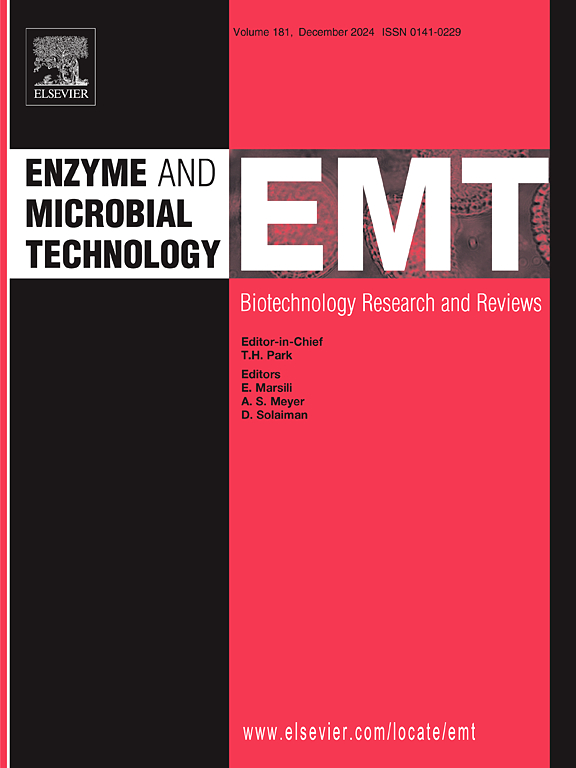通过人工低聚物的形成提高了产自equorum葡萄球菌的锰超氧化物歧化酶的热稳定性
IF 3.7
3区 生物学
Q2 BIOTECHNOLOGY & APPLIED MICROBIOLOGY
引用次数: 0
摘要
锰超氧化物歧化酶(MnSOD)是清除活性氧(ROS)的重要酶。它作为二聚体具有活性,但温度升高导致二聚体解离,从而降低酶的活性。在equorum葡萄球菌MnSOD中,二聚体在大约55°C时解离,而单体在大约67°C时展开。以前试图加强二聚体界面的相互作用通常会导致酶活性降低和/或稳定性降低。最近,在界面附近引入一个额外的相互作用,成功地提高了二聚体的解离温度。然而,由于这种相互作用是非共价的,单体在高温下仍然分离。为了防止解离,可能需要一个共价键。在这里,我们发现通过D47C和D47CE115C突变引入分子间二硫键促进了低聚物的形成。与野生型相比,突变型酶具有更强的抗解离性,显著提高了二聚体的热稳定性,并保持了酶活性,在高温下保持了其功能的完整性,从而为酶在生物技术和医学中的应用铺平了道路。本文章由计算机程序翻译,如有差异,请以英文原文为准。
Improved thermal stability of manganese superoxide dismutase from Staphylococcus equorum through formation of artificial oligomer
Manganese superoxide dismutase (MnSOD) is an important enzyme to remove reactive oxygen species (ROS). It is active as a dimer, but increasing the temperature leads to dimer dissociation, which in turn reduces enzyme activity. In Staphylococcus equorum MnSOD, the dimer dissociates at approximately 55°C, while the monomer unfolds at around 67°C. Previous attempts to strengthen interactions at the dimer interface have typically resulted in reduced enzyme activity and/or reduced stability. Recently, introducing an additional interaction near the interface successfully raised the dimer dissociation temperature. However, since this interaction was non-covalent, the monomers still separated at high temperatures. To prevent dissociation, a covalent bond might be required. Here, we show that introducing intermolecular disulfide bonds by the D47C and D47CE115C mutations promoted oligomer formation. The mutant enzymes exhibited enhanced resistance to dissociation, significantly improved the dimer’s thermal stability, and retained enzymatic activity compared to the wild type, maintaining their functional integrity at high temperature, thus paving the way for application of the enzyme in biotechnology and medicine.
求助全文
通过发布文献求助,成功后即可免费获取论文全文。
去求助
来源期刊

Enzyme and Microbial Technology
生物-生物工程与应用微生物
CiteScore
7.60
自引率
5.90%
发文量
142
审稿时长
38 days
期刊介绍:
Enzyme and Microbial Technology is an international, peer-reviewed journal publishing original research and reviews, of biotechnological significance and novelty, on basic and applied aspects of the science and technology of processes involving the use of enzymes, micro-organisms, animal cells and plant cells.
We especially encourage submissions on:
Biocatalysis and the use of Directed Evolution in Synthetic Biology and Biotechnology
Biotechnological Production of New Bioactive Molecules, Biomaterials, Biopharmaceuticals, and Biofuels
New Imaging Techniques and Biosensors, especially as applicable to Healthcare and Systems Biology
New Biotechnological Approaches in Genomics, Proteomics and Metabolomics
Metabolic Engineering, Biomolecular Engineering and Nanobiotechnology
Manuscripts which report isolation, purification, immobilization or utilization of organisms or enzymes which are already well-described in the literature are not suitable for publication in EMT, unless their primary purpose is to report significant new findings or approaches which are of broad biotechnological importance. Similarly, manuscripts which report optimization studies on well-established processes are inappropriate. EMT does not accept papers dealing with mathematical modeling unless they report significant, new experimental data.
 求助内容:
求助内容: 应助结果提醒方式:
应助结果提醒方式:


